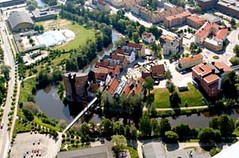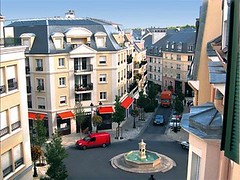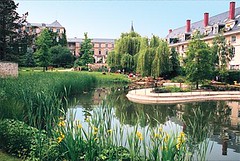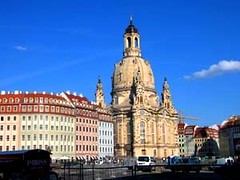Europe’s best new neighborhoods stress smart, green features

Posted September 4, 2008 at 1:55PM
A jury of top international architects and urbanists has selected ten winners of the Philippe Rotthier European Prize for the best urban neighborhoods built in the last 25 years. The winners are all fabulous projects featuring revitalization, walkable design, mixed use, sustainability, respect for historic precedent, and affordability – the building blocks of smart growth.
For example, the rebuilt center of Plessis-Robinson, a Paris suburb near Versailles, had declined into a sad collection of dilapidated public high-rises not unlike similar public housing failures in Chicago and New York. An enlightened mayor, Philippe Pemezec, took office in 1989 with a new vision and the suburb today, to borrow the words of Laurence J. Aurbach, a US urbanist and frequent contributor to the commentary on this blog (thanks, LJ), has become a model of “parks and flowers, clean water, recycling, compact and walkable urban design, transit, nonpolluting vehicles, and green technical and administrative procedures for city government.”
Writing in the excellent planning blog Ped Shed, LJ notes that the old suburb had long featured an idealistic streak as a “garden city,” even naming itself after the idyllic setting of the classic children’s novel The Swiss Family Robinson, before eventually falling into disrepair. “Much of the public housing was renovated, while other sections were demolished and redeveloped. The redevelopments recognized by the prize (Coeur de Ville, Quartier du Bois des Vallées, Cité Jardins, and others) were created between 1993 and 2005, and [integrate] old and new development patterns.” Plessis-Robinson was selected by the Rotthier jury as best example of suburban revitalization, as well as the grand prize winner.
LJ and I each selected three of the ten winners to feature in our blogs, and we overlap not only on Plessis-Robinson but also on my second example, the rebuilding of the Neumarkt district around the historic Frauenkirche in Dresden, a city mostly destroyed by World War II bombing. The striking church was fully restored in 1993, and the Neumarkt district began restoration thereafter to historic specifications. It now looks like it has always been there:
LJ notes that Dresden is a demonstrated leader in urban sustainability:
“About 57 percent of all trips are by walking, biking and transit; the city’s extensive and unusually diverse transit system includes light rail, commuter rail, long-distance rail, buses, ferries, a funicular railway and cable cars. Between 1996-2005 the commuting mode share for automobiles decreased from 73 to 62 percent, while the share for transit increased from 13 to 19 percent. Dresden is a member of the Climate Alliance of European Cities and has reduced its CO2 output more than 25 percent since 1987.”
The Neumarkt district was selected as best reconstruction of an historic center.
 Borgo Citta Nuova in Alessandria, Italy, selected as best neighborhood center, was built on an old industrial site and features three public pedestrian piazzas and a series of buildings with small shops on arcaded ground floors and apartments above. Building materials and design were selected to fit with historic patterns indigenous to the region. Borgo Citta Nuova was designed by renowned urbanist Leon Krier and Tagliaventi & Associates.
Borgo Citta Nuova in Alessandria, Italy, selected as best neighborhood center, was built on an old industrial site and features three public pedestrian piazzas and a series of buildings with small shops on arcaded ground floors and apartments above. Building materials and design were selected to fit with historic patterns indigenous to the region. Borgo Citta Nuova was designed by renowned urbanist Leon Krier and Tagliaventi & Associates.
The complete list of winners is on the Rotthier Prize’s website and includes the following:
- Plessis-Robinson, France, Best Operation of Urban Renaissance in a Suburban City (also Grand Prize winner)
- Val d'Europe, France, Best New City
- Neumarkt, Dresden, Germany, Best Reconstruction of an Historic Center
- Palermo, Italy, Best Reconstruction of a City Center
- Poundbury, Dorchester, UK, Best New Village
- Gladbeck, Germany Town Hall Neighborhood Center, Best Public Intervention
- Alessandria, Italy, Borgo Città Nuova, Best Neighborhood Center
- Irun, Spain, Best Urban Plaza
- Heulebrug, Belgium, Best New Garden-City
- Akroken, Sundsvall, Sweden, Best New Campus
 Writing in the July-August New Urban News, senior editor Philip Langdon notes that the Rotthier Prize winners represent a break from the modernist architecture most often associated with latter-decades architecture in Europe. Langdon also observes that most of the 88 finalists for the prize are private-sector developments, more subject to market forces that favor traditional design than are government-sponsored modernist projects. (Personally, I take no position on the modernist-versus-traditionalist debate. Both can be beautiful, humane, and sustainable.)
Writing in the July-August New Urban News, senior editor Philip Langdon notes that the Rotthier Prize winners represent a break from the modernist architecture most often associated with latter-decades architecture in Europe. Langdon also observes that most of the 88 finalists for the prize are private-sector developments, more subject to market forces that favor traditional design than are government-sponsored modernist projects. (Personally, I take no position on the modernist-versus-traditionalist debate. Both can be beautiful, humane, and sustainable.)
LJ Aurbach sums up the emphasis on sustainability:
“Not only are the winners beautiful and functional, they were judged to have been conceived and designed according to many of the principles of sustainable development and the EU Green Paper for the Urban Environment. These include revitalization of existing cities and suburbs with compact, mixed use development;
integrating land use and transportation for more walking, biking, public transit and fewer motor vehicles; harmonious small and medium industry; energy efficiency and green building; waste reduction and recycling; parkland and integrated soil and water management; and not least, to ‘defend the architectural heritage against the uniform banality of the international style, respecting rather than imitating the old.’”
These places all look wonderful to me. Compare the Rotthier Prize winners with the top ten new American neighborhoods and most walkable US cities and neighborhoods cited in my previous posts. Where we find similarities, we find principles we would do well to emulate.



